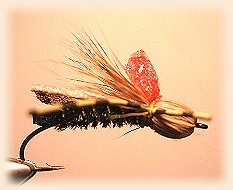Harts Skwalla Stonefly
Fly and Photos by Benjamin A. Hart (benjo)
Missoula, MT.
Spring's breath of life into Montana rivers
is a much anticipated event amongst fly-fishermen,
and most everyone else in Montana save for the
powder-hounds and snow bunnies. Until spring,
those brave enough to weather icy guides and
frozen wader-boot laces have enjoyed limited
success, sometimes on midges, mostly on sub-surface
flies. Balmy days bring forth one of the best
hatches of the year: the skwalla stonefly.
The hatch is the first of the "larger" foods
available to trout on the surface and anglers
take notice. Fishing a size 6 or 8 fly on the
tail of winter is a hard to suppress secret
here in Montana. There are plenty of great
rivers to fish the skwalla hatch on but there
is no better place to fish it than on Montana's
Bitterroot River, characterized by it's slightly
warmer temperatures, incredible trout cover and
abundance of insect life.
The Skwalla stonefly is an average stone, living
life as nymph for only one year feeding on debris
in on the river-bottom and emerging sometime
between the middle of March and the middle of
April. The Skwalla doesn't win many popularity
contests amongst the other stones, most of them
hatching at a better time of year for Montana
travel. It's not as terrifying as the salmonfly
or as predictable as the goldenstone, but to many
fishermen remains the most rewarding to be on the
water for. Many factors determine angler success
during the hatch. Unpredictable colder weather in
the spring can make the bugs disappear for a while
only to reemerge a few days later. A few warm days
can melt high elevation snow bringing cloudy water
that will turn the fish off. Anglers seeking out
the hatch should observe closely, asking these
questions: Are there exoskeletons on rocks near
shore? If the answer is yes, chances are that
trout are still looking up for a meaty skwalla.
Are there skwallas in the air? Seeing a skwalla
in the air or on the water is the main indicator
that the hatch is on. Unlike salmonflies and to
a lesser extent golden-stones, skwallas rarely
hatch in droves, and seeing one on the water or
in the air is reason enough to tie on one. If you
see some around, the trout have taken notice too
and will be looking for them. Taking the time to
look closely can make all the difference in the world.
Unlike other stonefly emergence, the skwalla
doesn't follow any particular pattern and fishing
on the Bitterroot could be the just as good on
any stretch of river on any given day. Anglers
don't have to chase skwallas upriver so pressure
from fishermen isn't as much of a factor as on
other rivers during more noted hatches, and
shoulder season traffic means it's reasonable
to expect to have a beat to yourself especially
with a little walking. The Bitterroot has miles
of braided channels that are not to be overlooked
during this hatch. One can work braid after braid,
never seeing a boat or another angler, always with
the chance of hooking truly large fish. Fish will
be holding in likely water and distributed throughout
the river, from a riffle two feet deep to a rip-rap
bank or a root filled undercut, if a spot looks
suspect it's worth a cast. Really any water deep
enough to hold trout can, and probably does at
this time of year, so you're better off staying
away from the bigger, slower pools, which
incidentally, is about the only place you'll
have any competition.
Western Montana fly tiers have probably concocted
more skwalla patterns than any other. Many have
looked forward to little more than the skwalla
hatch all winter long while huddled over piles
of tying materials. Most successful patterns
have the same key elements. When caught in the
current a natural skwalla rides very low in the
water, and good patterns imitate that. Many
patterns are tied in a drop down style, sometimes
on a bent shank hook that forces the abdomen of
the pattern to ride well below the surface. This
style not only coaxes more fish to eat it, it
also guarantees more hookups. Patterns made of
foam designed to ride flat often produce strikes,
and are a necessary addition to any box. For more
turbulent water the fly of choice is a parachute
pattern with a large poly-parachute, easily seen
and able to float all day. Often a looker might
say hello to a pattern and decide something is
wrong, having other patterns on hand is critical.
If a fish denies your fly, quickly tie on a different
style and cast for the same fish, you'll often get
that fish.
Planning a trip to the Bitterroot can be a little
dicey. With runoff imminent it becomes hard to
plan a trip far in advance. High elevation snow
will melt and blow the river out a little bit
here and there, but the clarity and fishability
will bounce back in a few days. Keep in mind
that the upper river is relatively small and
a change of a few hundred cubic feet per-second
(CFS) of water represents a drastic increase in
the volume of water in the river. On the lower
river such a change is not as much of a factor.
The best advice for planning a skwalla trip is
to watch the weather, check the stream flows at
https://waterdata.usgs.gov/mt/ and check the
weather forecast even though it's rarely right
for the region. The worst that could happen is
a change of plans for a day on Rock Creek, The
Clark Fork or Blackfoot Rivers, all in the area
and all wonderful fisheries. Finally, give
yourself time. With dynamic conditions your
best ally is a few extra days to try another
fishery while you wait for the Bitterroot to
come into its own.
Materials Harts Skwalla
Hook: Daiichi 1270, Size 4.
Underbody: Craft foam, a tapered
rectangle and hanging out the back to make
the egg sack.
Body: 7 or 8 strands of peacock herl,
counterwrapped with fine gold tinsel.
Wing: Montana Fly Company Etha-Wing
Material "Mottled Web".
Head: Deer Hair, a little smaller
diameter than a pencil.
Legs: Montana Fly Company Green
Barred rubber legs.
Post: Foam.
Notes: The hook size is critical to the success
of the pattern, I know it appears to be the wrong
size. The Tapered foam underbody gives a good
profile and it's best to not wrap it too tight.
See attached photos.
Tying Instructions: Harts Skwalla
1. Start thread on hook leaving the hook bare
near the eye, this will make it easier to spin
the hair on later.
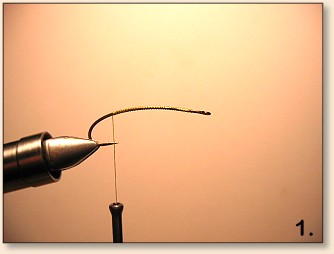
2. Take thread back so it hangs down right
in the middle of the barb.
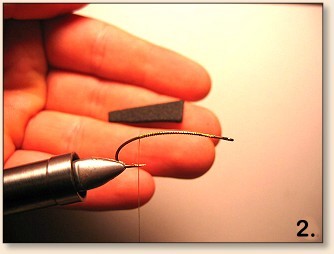
3. Cut out a long tapered rectangular piece
of craft foam and bind it to the hook leaving
a little bit poking out to be the egg sack.
Don't bind it too tight to trap air pockets
and help the body taper.
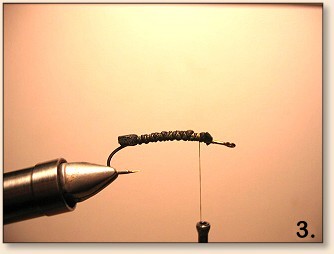
4. On your way back to the rear, bind down a
small or extra small piece of mylar tinsel.

5. Tie in 7 or 8 strands of peacock herl at
their tips. Wind them forward and counterwrap
with the tinsel.
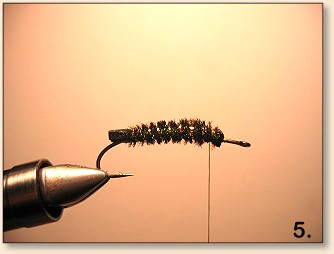
6. Cut out a stonefly shaped wing from Montana
Fly Company etha-wing material and bind it down
on top of the abdomen.
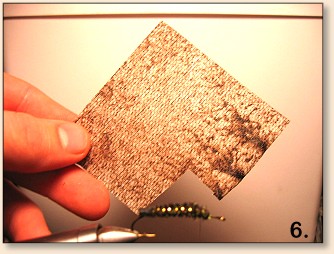
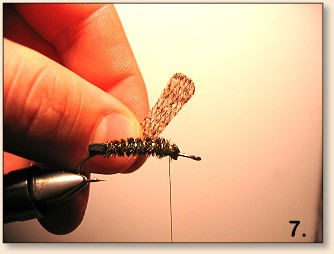
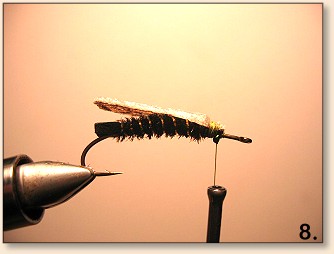
7. Stack, clean and spin a clump of deer hair
about the size of a pencil at the eye of the hook.
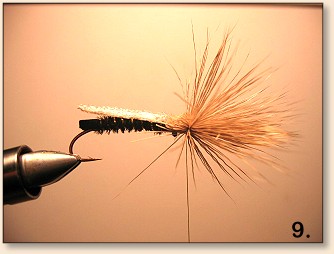
8. Pull back deer hair to make bullet head.
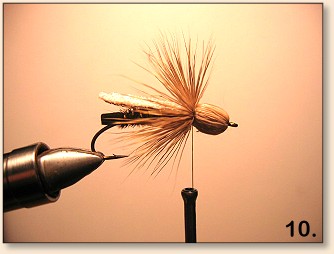
9. Clip the deer hair on the bottom.
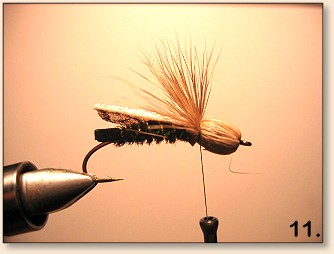
10. Add Montana Fly Company centipede legs, or
similar and add post, I prefer packing foam
that you sometimes find on DVD players and
other electronics.
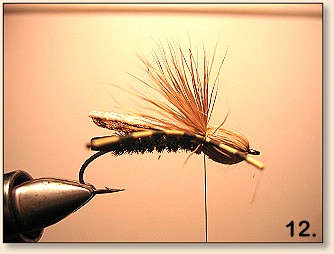
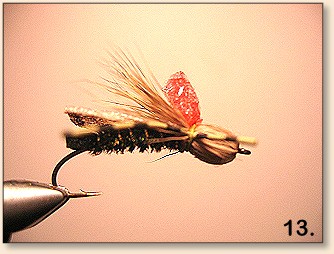
Top View:
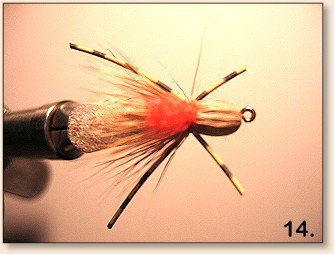
Fish-Eye's View:
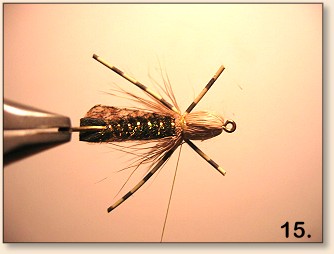
More!
I developed this pattern a few years ago in my
search for the perfect blend of visibility,
general lifelikeness, and readily available
materials. I gave a few to my good friend Nick
and he called me that night to tell me that he
caught 40 fish on one fly. The Hart Skwalla was
born and has since taken many picky fish on the
Bitterroot and other rivers. I chose the hook style
because I wanted the body to ride low in the water
because fish will often short strike a skwalla
pattern. I also opted for a hook one size bigger
than the pattern to drop that point down even more.
Don't forget to grease the deer hair and the top of
the wing, and tight lines. ~ Benjamin A. Hart (benjo)
|

